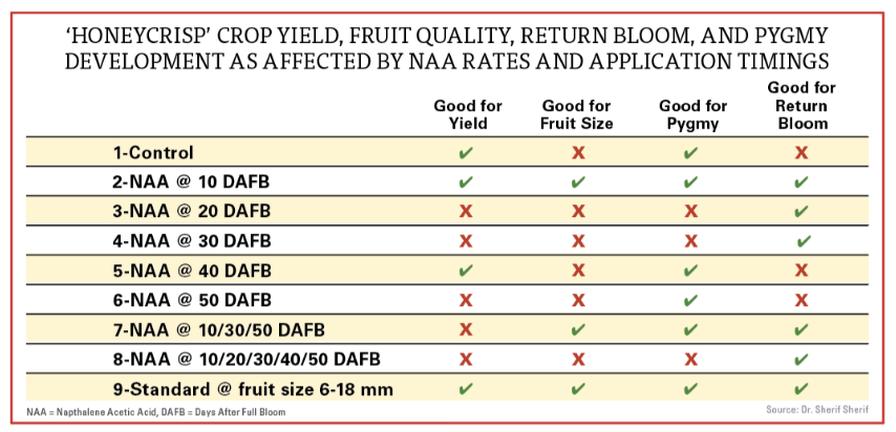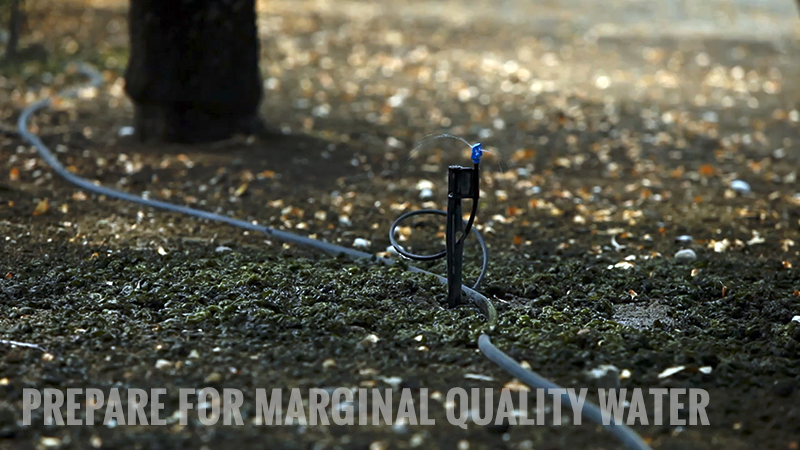PGR Progress and Apple Production: Don’t Delay on the NAA
Intent on determining the effect of plant growth regulators (PGRs) on return bloom and thinning of apples, Dr. Sherif Sherif started from scratch in 2017. The Assistant Professor of Pomology at Virginia Tech de-fruited an entire block of ‘Honeycrisp’/B.9 to create an “off year.”
In 2018 — the ensuing “on year” — he divided those trees into two groups:
Group A included six subsets of no thinning (15 fruit per centimeter) combined with applications of either Apogee (prohexadione calcium, BASF), Blush (prohydrojasmon, Fine Americas), Apogee plus Blush, ethephon, PoMaxa (naphthalene acetic acid/NAA, Valent USA), or ethephon plus PoMaxa.
Group B included three subsets of de-fruiting combined with applications of either ProVide (gibberellins, Valent USA), ProTone (abscisic acid, Valent USA), or ProVide plus ProTone.
Finally, in 2019, the trees were evaluated for percentage of return bloom.
“I wanted to see which one of these chemicals can enhance or decrease returning bloom in the following season,” Sherif says.
The trees that had been de-fruited a year earlier resulted in 100% return bloom (50 of 50 buds per tree) regardless of chemical combination. Just as un-desirable, all the trees that had not been thinned exhibited almost zero return bloom. All but one, that is.
The lone treatment that stood out was PoMaxa, the NAA that, in combination with no thinning, exhibited 20% return bloom (10 of 50).
“So, starting from 2019, I started advising all growers in Virginia that, if you need to enhance return bloom in ‘Honeycrisp’, you don’t need to focus on ethephon, you need to focus on NAA,” Sherif says.
Three years later, Sherif, who presented at the Great Lakes Fruit and Vegetable Expo in early December, is still breaking down the benefits of NAA.
TIMING IS EVERYTHING
Sherif has been adamant to remind growers that waiting until mid-June or July for return bloom applications will be too late with ‘Honeycrisp’ and ‘Fuji’. Such varieties, which are prone to biennial bearing, initiate flower formation much earlier in the season than annual cropping varieties. ‘Gala’, for example, reaches peak flower bud initiation around 85 days after full bloom (DAFB), whereas ‘Honeycrisp’ (45 DAFB) and ‘Fuji’ (65 DAFB) do so much earlier.
“It’s already done. The decision has been made already within 45 days after bloom,” Sherif says.
But what is the exact best time to apply NAA? Sherif answered that question after testing the effects of different rates and application timings of the NAA Refine (Fine Americas) at 4 fluid ounces per 100 gallons of water.
With control, the result was nearly zero return bloom. NAA applied at both 10 DAFB and 20 DAFB resulted in 40% return bloom. Applied at 30 DAFB, NAA posted 75% return bloom. Ten days later, at 40 DAFB, the return bloom fell back to 5%.

“Now we know exactly what the best timing is for application,” Sherif says.
When compounded with other factors, such as yield, fruit size, and pygmy fruit development, that would be NAA at 10 DAFB (see chart above). Equally successful overall is the industry standard of 3 fluid ounces of Refine plus one pint of carbaryl per 100 gallons of water applied on fruit sized between 6 mm and 18 mm.










